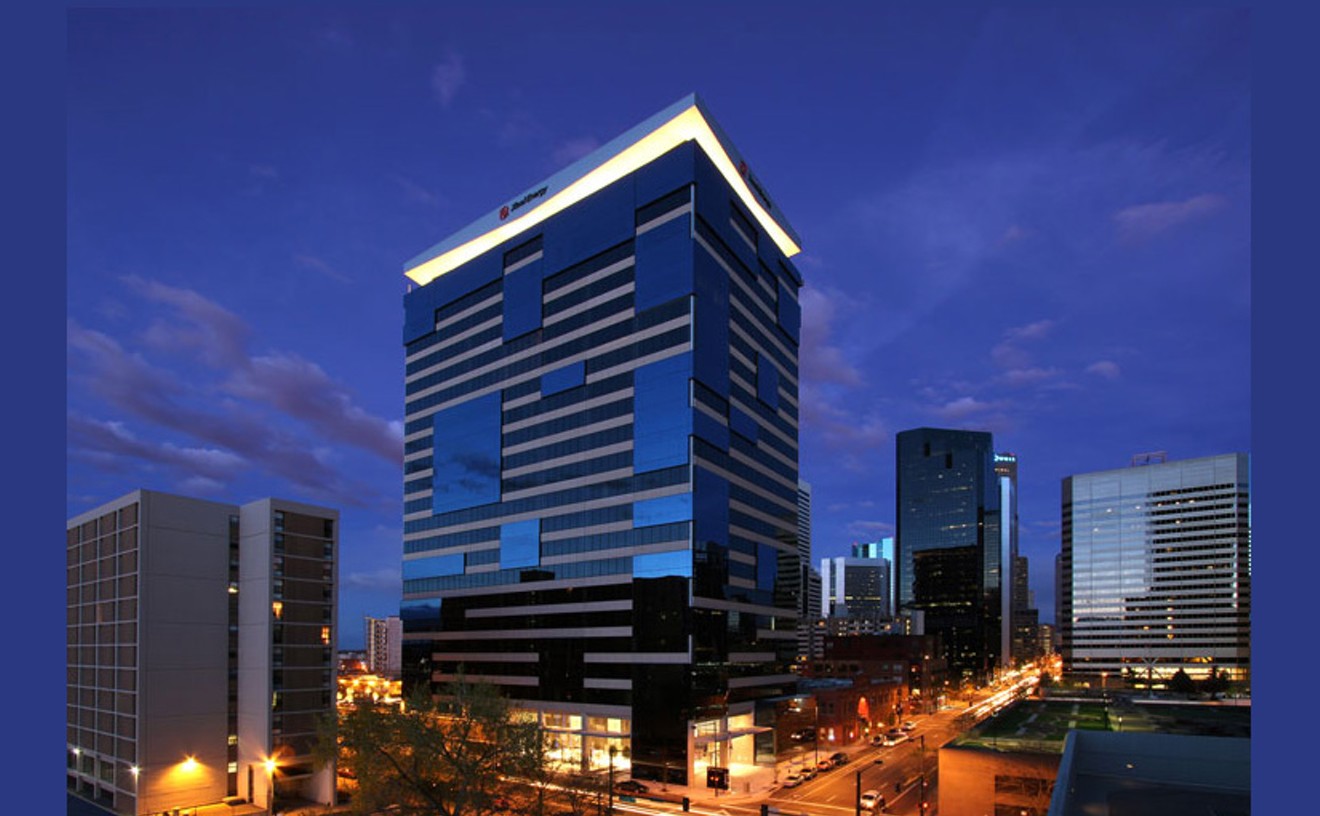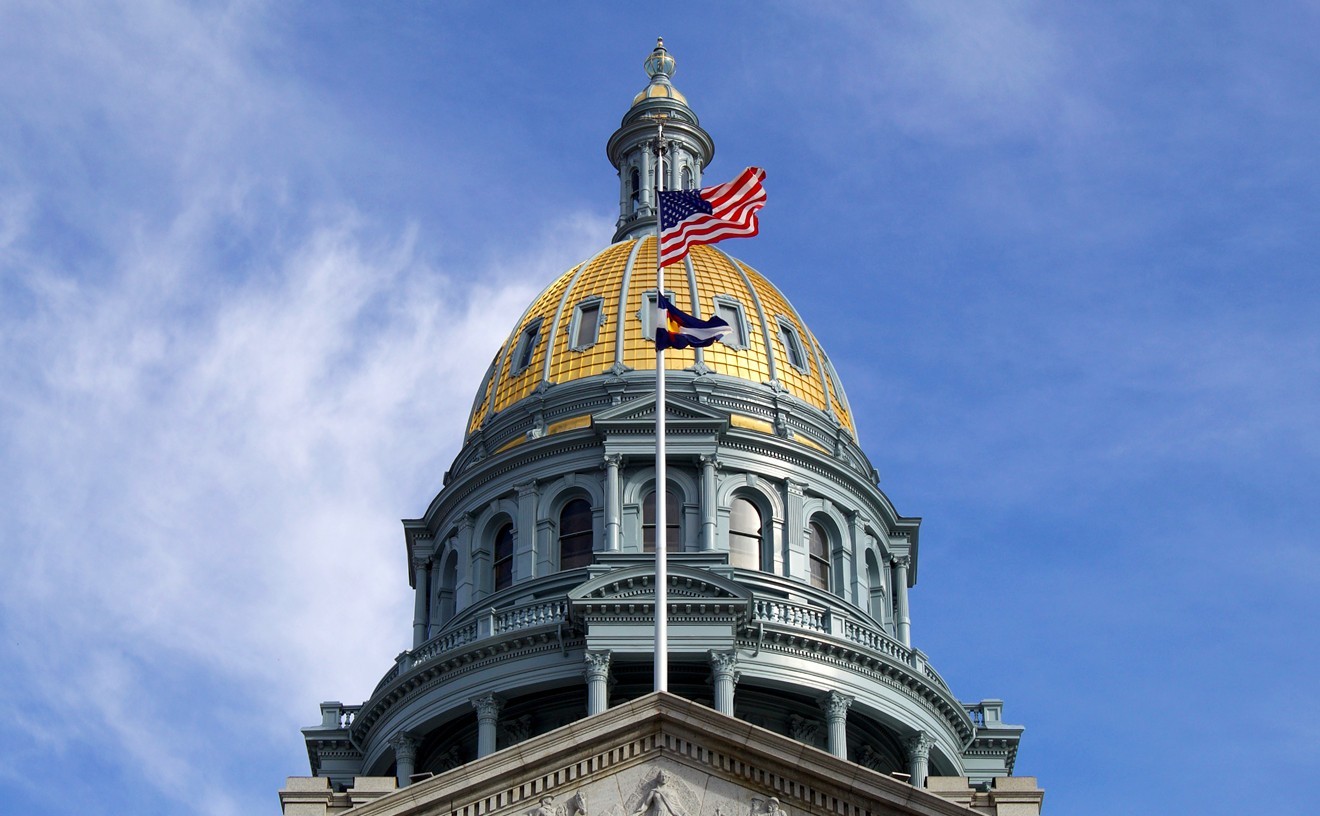Urban camping is now banned in Denver.
But the city's controversial new ordinance designed to cut down on the unpleasant problem of the homeless sleeping on sidewalks and along the 16th Street Mall doesn't solve the puzzle of Triangle Park — better known as the "Bumuda Triangle."
Back in the '20s, as out-of-work men started traveling the country, overnight camping was banned in all of Denver's city parks, including this tiny sliver at Park Avenue West and Lawrence, one of five triangular traffic islands created when Broadway cut through downtown almost a century ago as part of Mayor Robert Speer's City Beautiful project. Perhaps this spot was once beautiful, but for more than a year, the city has been trying to figure out what to do about the blight stuff at this corner, where the homeless who sleep at the Denver Rescue Mission across the street or the St. Francis Center around the corner or the Salvation Army around another corner or the Samaritan House up the street now hang out during the day, when the shelters are closed.
And although Denver City Council members managed to author, and approve, and even implement an urban-camping ban in a fraction of that time, Triangle Park remains a mess. The ban will only make it tougher to clean up, as service providers scramble to increase bed space; the Denver Rescue Mission is considering a project that would add 500 spots, for example, and other facilities are looking at all-night drop-in centers after the parks close at 11 p.m. and the homeless are pushed off the 16th Street Mall into outlying areas.
There are more than three sides to this triangle. "This is not really the way it was envisioned," a Denver Parks and Recreation official admitted last summer ("Bums' Rush," June 9, 2011). Six years ago, the city poured more than $300,000 into the park, turning a barren patch of dirt and asphalt into an elegant space named in honor of Edward J. "Eddie" Maestas, the unofficial Mayor of Larimer Street. Maestas always had a soft spot for the homeless, as well as the then-down-and-out area where he bought Johnnie's Market at 2030 Larimer Street in 1975; he never gave up on the people or the place, and fought to improve the lot of both. In recognition of his efforts, in November 2006 the Denver City Council okayed the renaming of Triangle Park by approving one of the longest ordinances ever presented to that group, a flowery ode to Maestas penned by urban planner Karle Seydel, the first director of the Larimer Square North Merchants' Association, who worked with Maestas to reclaim the neighborhood then known as NoDough.
Neither Maestas nor Seydel lived to see the neighborhood become one of the hottest areas in town, as expensive lofts and chic new restaurants moved in right next to the shelters and service providers. They didn't live to see the park return to its status as a dumping ground, where drug dealers prey on the homeless who hang out on the wall all day because they have nowhere else to sit, where city employees arrive at six every morning to tend to a patch of land that takes far more time to clean up than parks ten times its size, digging through the native grasses meant to deter loitering that now hide needles. The situation got so bad that Maestas's family asked that the sign in the park honoring Eddie be taken down. It was. But it's not as easy coming up with a solution.
At about the same time the city was starting to fix up Triangle Park — for the first time — Jon Schlegel bought the building at 2260 Larimer that was once the dance hall where Eddie Maestas met his wife, Helen. Schlegel turned it into Snooze, one of the first hip hangouts in this part of Denver. "Coming into the neighborhood, I knew our anchors were shelters and Coors Field," Schlegel recalls. "That's what makes a big city: co-existence." He learned a lot about co-existence living upstairs from the restaurant for the first eighteen months, and he and his partners and employees got used to washing the sidewalk every morning, escorting early customers past gangs of miscreants who always seemed to gather during the Denver Police Department's shift change. (The corner of Park and Broadway is responsible for more cop calls than any other spot in town.) He's worked with other businesses in the neighborhood to find a solution, but it remains elusive. "It's so weird that it gets so much more difficult," he says. "I feel that it's as dangerous as it ever was."
A year ago, the city signed a memorandum of understanding with the Denver Rescue Mission, which would have let that agency take over management of Triangle Park, essentially walling it off into an area where the homeless could congregate during the day but also be protected. Instead of sealing that deal, though, the city started looking at other possibilities, working with a group of stakeholders that included local businesses like Urban Market Partners, the Ballpark Neighborhood Association and nearby residents of Five Points and Curtis Park. "From my perspective, it's clearly not functioning as a park," says Lauri Dannemiller, manager of Denver Parks and Recreation. "We're discussing what other options are out there to get it back to a park."
And the discussion keeps growing. The group developed a unique metropolitan district, Community Coordinating District No.1, after Eddie Maestas Park was chosen for a pilot project to devise a comprehensive plan for the area that includes not just Triangle Park, but stretches up to 24th Street and over to Sonny Lawson Field on Welton Street. The group has been meeting weekly to talk about possibilities, then continuing the talk on the web. Over the past few months, the proposal for a walled enclosure has morphed from a space enclosed by rocks and wire to a park protected by photos of faces and quotes. And there are other concepts on the site now, too: turning the park into an information kiosk; building an attractive, angular area that would be impossible to occupy — like the Holocaust museum in Los Angeles; transforming it into an art space, with exhibits and performances.
At a meeting last Monday night, two artists proposed rooting it with "The Tree," a thirty-foot-tall art piece that would allow the homeless to share their stories. "Housed in an interactive sculpture, streaming images that are both homeless and non-homeless faces. By blending and weaving the faces together, people driving through the area would not know if they are looking at a homeless face or a non-homeless face," the artists proposed. "The large-scale faces would be impossible to ignore, and will raise questions regarding identity and who are the homeless."
But for one service provider, that proposal also raised very real concerns: Many of the homeless are mentally ill, he pointed out; they don't need voices speaking to them from overhead.
The wall came in for criticism, too. The city has already been accused of "criminalizing homelessness," with opponents of the ban wearing "Homes, not handcuffs" buttons. How would the rest of the country respond if they heard that Denver was "fencing in the homeless"? Even if that fence kept out the drug dealers?
"At the end of the day," said developer Amy Harmon, "everybody's just trying to have a happy, safe place to be."
John Hayden, a resident who's led the weekly discussions, summarized the discussion thus far with a smart PowerPoint that walked people from Sonny Lawson Park — where the ball field was fenced off decades ago to separate the athletes from what were then known as "bums" — to Triangle Park. The ballpark fence should be the first thing to go, the group agreed, returning that park to the place that Jack Kerouac described in On the Road, where the crowd that gathered to watch softball games would include "all humanity, the lot."
All humanity was at Snooze two weeks ago, the weekend before the Denver City Council approved the urban-camping ban. Some of that humanity was outside, where Occupy Denver was demonstrating against the restaurant for supporting the ordinance. And some of it was in the kitchen: Schlegel regularly hires the homeless, and there were four homeless workers at Snooze that day. "It was so odd. They kept coming out and asking, 'Jon, what is wrong with these people?'" he says. "If we criminalized the homeless, I'd have no kitchen help."
On June 18, the Community Coordinating District stakeholders will again gather at RedLine to vote on their favorite proposal, which could forever change the shape of Triangle Park. (Until then, anyone can see the ideas — and add their own — at www.communitycoordinatingdistrict.com.) "I'm real optimistic about everything going on," Eddie Maestas said back in 1997, two years after Coors Field opened two blocks from the store he had to close after he was diagnosed with leukemia. "I see nothing but good for this area."
Maybe one day soon, Denver's vision will finally be worthy of Eddie's name.











